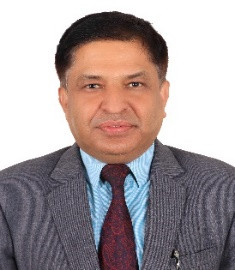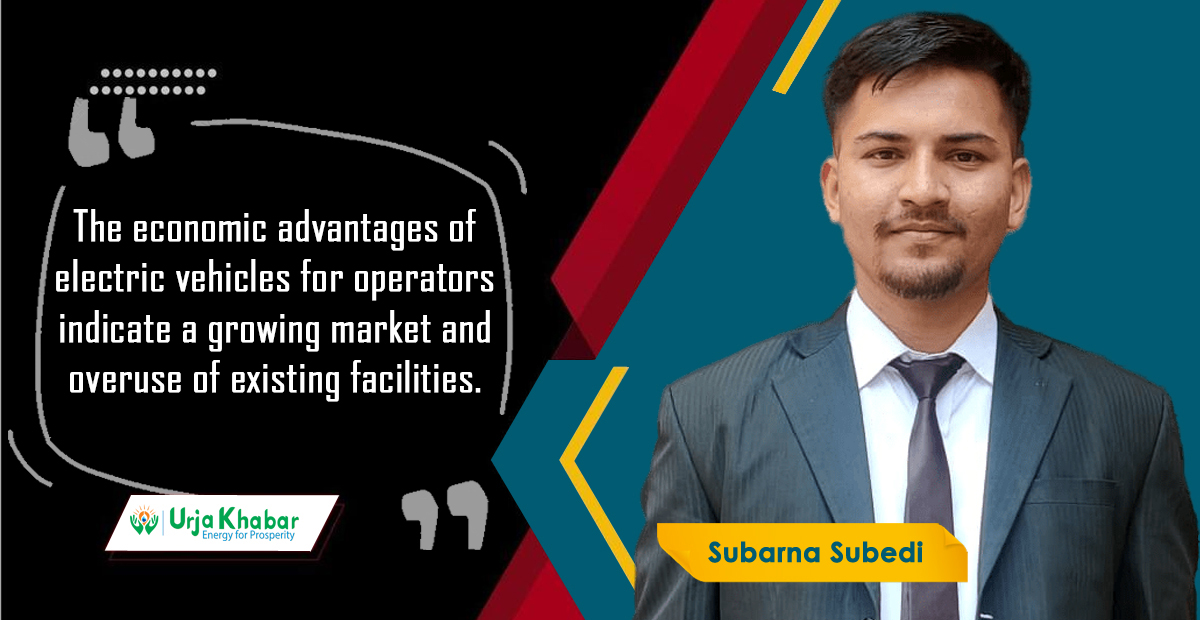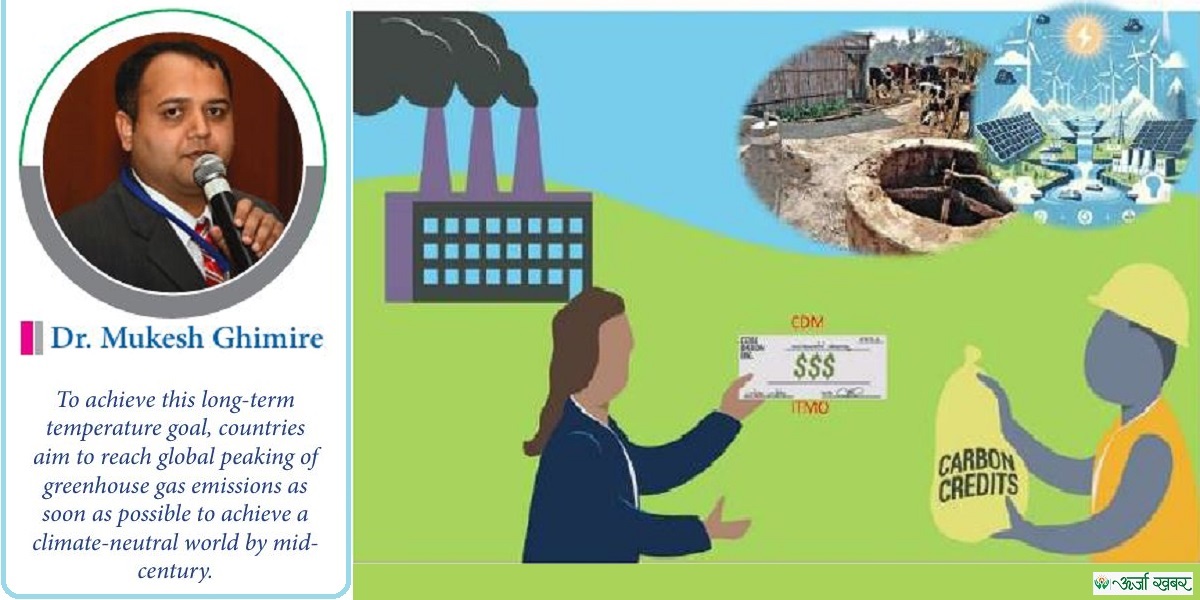Energy Update
Nepal's Clean Energy Transition Plan and Pathway
.jpg)
1. National Context
Nepal’s clean energy transition plans and pathway are widely recognized as being the key driver to the nation’s future green economic growth. The largest available renewable energy resource is hydropower, with a potential of approximately 83,000 MW, while economist and technocrat argue it could be more than this if it is done wisely in regional integrated planning. The latest statistics shows that access to electricity is to more than 95 percent of the country’s population. Small-scale renewable energy resources mainly micro and mini hydro, solar energy, wind energy and bio energy can also be harnessed to meet the energy demand, particularly the need for electricity and clean cooking demand of rural and remote areas of the country. But modernization on traditional fuels can contribute to an aim of achieving modern energy mix of the entire country which is the biggest task ahead.
Table 1 : Summary of electrified and un-electrified households, local units and wards

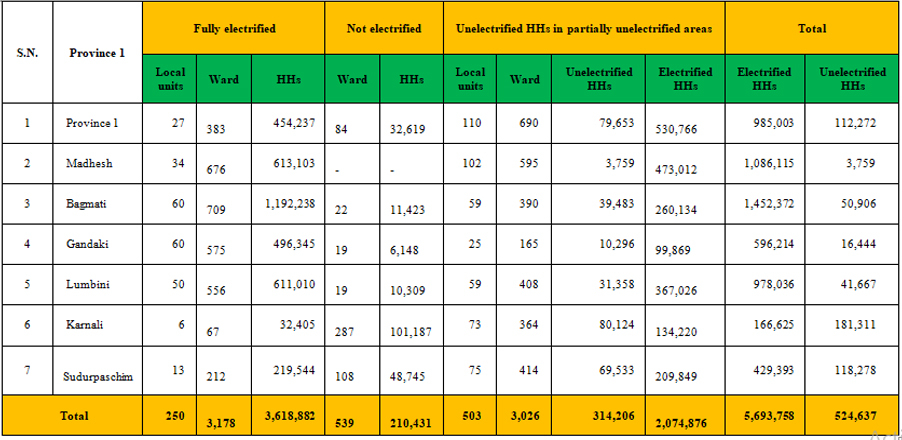
The Cross Border Energy Trade (CBET) can have a massive impact in clean energy transition in South Asia. With an addition of new hydro projects, the share of cleaner energy will increase in the region. A simulation conducted by the state-owned power utility Nepal Electricity Authority (NEA), shows that Nepal will be at the state of net electricity surplus by 2024, out of which Nepal will be a pure exporter of power on a RoY (Round-the-Year) basis. With an existing domestic annual electricity consumption growth rate of just 15 percent, the country cannot use surplus power, as Nepal currently lacks energy-intensive industries and electric mass-transport systems, which of course should be our future goal. In the long term, to achieve high economic prosperity and to maintain favorable trade balance, Nepal needs to export its hydroelectricity in the regional market, especially in India and Bangladesh.

The current availability of a high capacity interconnection links with India combined with policies for CBET, though selective, regional energy trading is now objectively possible. Nepal has already started to export around 400 MW of electricity to India. Nepal, Bangladesh and India are currently discussing on building further high capacity connectivity for inter nation bulk power trade. Bangladesh has expressed its interests to invest in the development of hydropower projects and to purchase electricity from Nepal.
As the climate change issues are currently in top global agenda and in the backdrop of the COP 26, where countries have pledged to reduce greenhouse gas emission and to promote the usage of clean/renewable energy technologies, Nepal’s abundant water resources can be tapped to ensure clean energy, while the country can play a significant role in the line in South Asia, in particular. It is now necessary to support survey, design, installation, operation and maintenance of renewable energy technologies that are resilient to climate change impacts in line with Loss and Damage Fund agreed upon by COP27 held in Sharm-El-Sheikh, Egypt in November, 2022.
2. Clean energy transition pathway
The Paris Agreement (Article 4) requires each party involved to outline, prepare and communicate their post 2020 climate actions named ‘Nationally Determined Contributions’ (NDCs). NDCs are at the heart of the Paris Agreement and the pathway in achievement of these long-term goals. NDCs embody efforts by each country to reduce national emissions and adapt to the impacts of climate change. Parties shall pursue domestic mitigation measures, with the aim of achieving the objectives of such contributions.
Nepal submitted its Second Nationally Determined Contribution (NDC) in December 2020, depicting our ambitious targets for the next decade towards clean energy transition, mitigate emissions and increase resilience of vulnerable communities. Nepal has targeted to expand clean energy generation to 15,000 MW by 2030. Out of this, 5-10 percent will be generated from mini and micro-hydro power, solar, wind and bio-energy. In transport segment, the sales of electric vehicles are targeted to take 25 percent of all private passenger vehicles sales and 20 percent of all four-wheeler public passenger vehicles sales by 2025. Similarly, Nepal aims to increase sales of e-vehicles to cover 90 percent of all private passenger vehicle sales and 60 percent of all four-wheeler public passenger vehicle sales by 2030.
Transport electrification strategies provide multi-fold benefits. Vigorous adoption of electric vehicles reduces the demand for petroleum products; hence it helps reduce Nepal’s reliance on imported energy resources and also contributes to climate mitigation through effective utilization of Nepal’s hydropower potential.
Electric cooking stoves are our priority technology in improving clean cooking access. Clean cooking solutions are definitely appropriate in terms of the health benefits, cost effectiveness, and little maintenance requirements. Residential cooking has been given priority, with a set target at 25 percent of households using electric stoves by 2030. Besides, ambitious targets are set for household-based and large scale biogas plants. Furthermore, with its Long Term Strategy for Net-zero Emissions, Nepal is committed to accelerating climate actions with the goal to achieve net zero emissions by 2045. Nepal has sought to earn recognition for its contributions to mitigation beyond its border through clean energy trade.
Table 2 : Targets of Country Action Plan on Clean Cooking

Aligning with Article 4, of the Paris Agreement, Nepal has formulated long-term low greenhouse gas emission development strategies (LTS) in October 2021. The LTS will further provide realistic time frame and measures to be considered for reaching net zero emissions by 2045. The key elements of LTS are to increase the use of clean/renewable power in all sectors. These include switch to clean and modern energy in all economic sectors, improve energy efficiency and maximize benefits by utilizing clean energy efficiently in the residential, industrial, and transportation sectors. Adoption of clean and secure electric-based mobility includes decarbonizing the transportation sector via use of alternative modes of transportation. Switch to electric mass transport means and increased use of clean fuels increase carbon sinks by managing forests and natural resources in a sustainable manner.
Enhanced sustainable agriculture and land use management to maximize co-benefits can help expand the circular economy to improve industrial sustainability, promote industrial sector modernization through installations, and invest in new carbon-neutral compatible technologies and systems. Deploy carbon removal technologies in all economic sectors and maximise benefits of the mitigation of clean energy trade where appropriate. Mechanisms for recognition are in place to enhance international cooperation and support (technical and financial) for climate actions (Mitigation and Adaptation).
Energy efficiency measures are being encouraged. Substantial energy savings can be achieved through sustainable heating technologies in the residential and commercial sectors. The utilization of efficient household appliances and implementation of best practices and state of the art technologies in industrial processes can reduce substantial amount of electricity demand which is much better than saving in extra generation expenses.
3. Plan and challenges for green transition
Being a landlocked country with mountainous terrain and without having proven fossil fuel reserve, Nepal is heavily reliant on imported fossil fuels. The dependence on fossil fuel import has not only widened the trade deficit, but also made Nepal prone to the risk of energy security. Among the additional challenges, Nepal is one of the nations that are most vulnerable to climate change because of the country’s fragile topography and climate-sensitive livelihoods of the people and their limited adaptive capacity. As a Least Developed Country (LDC) with an insignificant contribution to global emissions in the past and the present and having limited financial resources, Nepal has been hit hard by climate change. As Nepal aims to transcend to the status of a middle-income country by 2026, it is crucial to recognize the pathway that will ensure a sustainable green economic transition of the country. Energy plays a major role in the nation’s economic growth. Energy need is widespread in agriculture, transportation, industries, commercial and residential sectors. We need to account the usage of fossil fuel in various sectors of the country and identify ways for Nepal to reduce its reliance on imported fuel to safeguard its energy security from price fluctuations and supply shocks.
Figure 1 : Clean energy transition potential
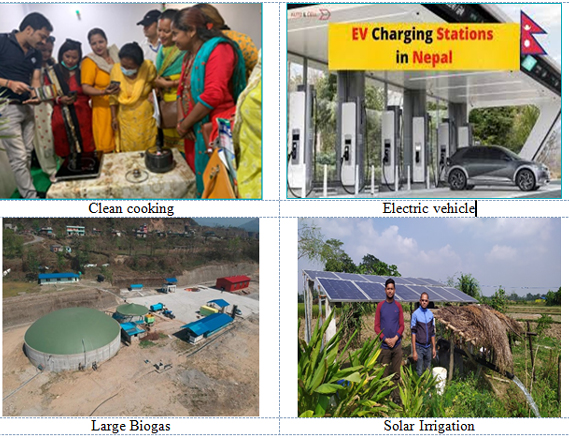
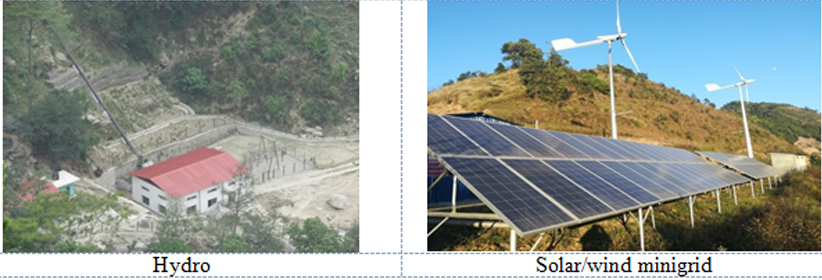
Clean energy adoption took place in Nepal in last decade. Over the period, Nepal has made significant progress in increasing its access to electricity. The off-grid coverage has been significant at rural and remote settings which are being overlapped by the expanding grid. More than 95 percent of the households of the country have access to electricity, while it is aimed to incorporate all the households by 2024. Given Nepal’s complex mountainous terrain and last-mile connectivity challenges, off grid generation and distribution approaches are needed to complement grid extensions.
Alternative Energy Promotion Centre (AEPC), under the aegis of the Ministry of Energy, Water Resources and Irrigation, has been nominated as a Direct Access Entity (DAE) of Green Climate Fund (GCF). This reveals a massive potential for green energy transition. Residential cooking/ heating and fossil fuel based transport system which is dominated by the usage of traditional fuel sources and LPG has imposed a challenge for Nepal in order to replace them with electricity. To mitigate the impact of climate change and strengthen resilience of the most vulnerable communities to adapt to climate change, AEPC is implementing project “Mitigating GHG emission through modern, efficient and climate friendly clean cooking solutions (CCS)” in cooperation of the Green Climate Fund (GCF).
The main objective of the project is to surge use of Clean Cooking Solutions by instigating innovative concepts of output based financing for de-risking of investments and mainstreaming and capacitating local governments in renewable energy (RE) sector. The five year project, with a total budget of USD 49.15 million, has an expected mitigation impact of 6.5 Million tCO2eq, with direct beneficiaries of one million household of 22 districts (150 municipalities/rural municipalities). The project aims to install 500,000 electric cookstoves, 490,000 Tier 3+ ICS and 10,000 biogas plants for households.
It is to be noted that in Nepal, the power system is mainly the hydro-dominated system, while the demands are covered primarily by run-of-river (ROR) and peaking run-of-river (PROR) hydropower plants. The ROR projects do not have storage facilities while the PROR projects have at an average 4 to 6 hours daily peaking storage. Lack of storage based hydropower is also one of the challenges that we face. Nepal’s Fifteenth Plan aims to diversify energy mix by maintaining reservoir and pumped storage projects at 30-35 percent, semi reservoir projects at 25-30 percent and other alternative projects at 5-10 percent. Nepal’s storage hydro capacity development needs huge financial resources, development time and most crucial reliable markets which again call for the regional co-operation and joint initiative. The recent meeting of Bangladesh, Bhutan, India and Nepal (BBIN) has also underlined joint initiative as the best approach to have joint discussion and investment to achieve green energy transition in the region.
4. Future outlook
It is to be noted that the targets set by the second NDC are mostly conditional and dependent upon mobilization of external resources. The cost of achieving Nepal's NDC conditional mitigation targets is estimated to be USD 25 billion. The nation needs strong political will and huge financial and technical assistance for implementing innovative and cost effective approaches for scaling up the clean energy projects in the country for climate change mitigation and adaptation. Capacity building of various actors, adoption of latest technologies and diverse business models suited to changing contexts are also equally essential. Technical knowhow and financial assistance of development agencies will play a vital role in accelerating Nepal’s clean energy transition.
For regional co-operation, efforts through the BBIN, the South Asian Association for Regional Cooperation (SAARC) and the Bay of Bengal Initiative for Multi-Sectoral Technical and Economic Cooperation (BIMSTEC) to have green growth and green economic co-operation will be instrumental and will also be in concurrence with the global initiative to resolve climate change issues that are discussed annually in COP.
The BBIN aims to formulate, implement and review quadrilateral agreements across areas such as water resources management, connectivity of power, transport and infrastructure. Energy cooperation can serve as a driving mechanism to take forward the SAARC. The BIMSTEC works on technological and economic cooperation, energy, technology, environment and disaster management and climate change among the Southeast Asian countries along the coast of the Bay of Bengal. Nepal can play a vital role in the region to share its green energy resources, on a timely and mutually beneficial way, with the region and the entire world.
The Writer is former Executive Director of Alternative energy promotion centre (AEPC) Nepal. This article taken from Urja Khabar bi-annual Journal published in 2022 Dec. 16th
Conversation
- Info. Dept. Reg. No. : 254/073/74
- Telephone : +977-1-5321303
- Email : [email protected]




